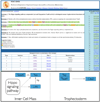Preimplantation development regulatory pathway construction through a text-mining approach
- PMID: 22369103
- PMCID: PMC3287586
- DOI: 10.1186/1471-2164-12-S4-S3
Preimplantation development regulatory pathway construction through a text-mining approach
Abstract
Background: The integration of sequencing and gene interaction data and subsequent generation of pathways and networks contained in databases such as KEGG Pathway is essential for the comprehension of complex biological processes. We noticed the absence of a chart or pathway describing the well-studied preimplantation development stages; furthermore, not all genes involved in the process have entries in KEGG Orthology, important information for knowledge application with relation to other organisms.
Results: In this work we sought to develop the regulatory pathway for the preimplantation development stage using text-mining tools such as Medline Ranker and PESCADOR to reveal biointeractions among the genes involved in this process. The genes present in the resulting pathway were also used as seeds for software developed by our group called SeedServer to create clusters of homologous genes. These homologues allowed the determination of the last common ancestor for each gene and revealed that the preimplantation development pathway consists of a conserved ancient core of genes with the addition of modern elements.
Conclusions: The generation of regulatory pathways through text-mining tools allows the integration of data generated by several studies for a more complete visualization of complex biological processes. Using the genes in this pathway as "seeds" for the generation of clusters of homologues, the pathway can be visualized for other organisms. The clustering of homologous genes together with determination of the ancestry leads to a better understanding of the evolution of such process.
Figures




Similar articles
-
LAITOR4HPC: A text mining pipeline based on HPC for building interaction networks.BMC Bioinformatics. 2020 Aug 24;21(1):365. doi: 10.1186/s12859-020-03620-4. BMC Bioinformatics. 2020. PMID: 32838742 Free PMC article.
-
GenCLiP 2.0: a web server for functional clustering of genes and construction of molecular networks based on free terms.Bioinformatics. 2014 Sep 1;30(17):2534-6. doi: 10.1093/bioinformatics/btu241. Epub 2014 Apr 23. Bioinformatics. 2014. PMID: 24764463
-
Computer-assisted curation of a human regulatory core network from the biological literature.Bioinformatics. 2015 Apr 15;31(8):1258-66. doi: 10.1093/bioinformatics/btu795. Epub 2014 Nov 29. Bioinformatics. 2015. PMID: 25433699
-
Mining biological networks from full-text articles.Methods Mol Biol. 2014;1159:135-45. doi: 10.1007/978-1-4939-0709-0_8. Methods Mol Biol. 2014. PMID: 24788265 Review.
-
Computational polypharmacology with text mining and ontologies.Curr Pharm Biotechnol. 2011 Mar 1;12(3):449-57. doi: 10.2174/138920111794480624. Curr Pharm Biotechnol. 2011. PMID: 21133848 Review.
Cited by
-
Inositol 1, 4, 5-trisphosphate-dependent nuclear calcium signals regulate angiogenesis and cell motility in triple negative breast cancer.PLoS One. 2017 Apr 4;12(4):e0175041. doi: 10.1371/journal.pone.0175041. eCollection 2017. PLoS One. 2017. PMID: 28376104 Free PMC article.
-
Evolutionary hallmarks of the human proteome: chasing the age and coregulation of protein-coding genes.BMC Genomics. 2016 Oct 25;17(Suppl 8):725. doi: 10.1186/s12864-016-3062-y. BMC Genomics. 2016. PMID: 27801289 Free PMC article.
-
A Review of Recent Advancement in Integrating Omics Data with Literature Mining towards Biomedical Discoveries.Int J Genomics. 2017;2017:6213474. doi: 10.1155/2017/6213474. Epub 2017 Feb 26. Int J Genomics. 2017. PMID: 28331849 Free PMC article. Review.
References
MeSH terms
LinkOut - more resources
Full Text Sources

